Content for TS 23.280 Word version: 19.5.1
1…
5…
6
7…
8…
9…
10…
10.1.5…
10.2…
10.2.6…
10.3…
10.6…
10.7…
10.7.3.8…
10.8…
10.9…
10.9.3.9…
10.10…
10.10.3
10.11…
10.12…
10.13…
10.14…
10.15…
10.16…
10.17…
10.18…
10.18.3…
11…
11.5…
A…
B…
C…
E…
10.9.3.9 Usage of location history reporting procedure
10.9.3.10 Usage of location information across MC systems procedure
10.9.3.11 Restrict location information dissemination procedure
10.9.3.12 Location reporting trigger override
...
...
10.9.3.9 Usage of location history reporting procedure |R17| p. 224
10.9.3.9.1 General p. 224
The location management client may get into a state where it cannot report location information to the location management server at any time after the initial location reporting configuration was provided by the location management server. If any location information trigger criterion applies, while not reporting location information to the location management server, the location management client stores the corresponding location information.
Trigger criteria while not reporting location information to the location management server may vary from trigger criteria while reporting location information to the location management server. Such trigger criteria may for example include not reported distance travelled, not reported elapsed time, not reported call initiation, not reported emergency alert, not reported emergency group call, not reported imminent peril group call and not reported emergency private call.
10.9.3.9.2 Report location history procedure p. 224
10.9.3.9.2.1 On-demand report location history procedure (LMC - LMS) p. 224
The location management server can request stored location information at any time from the location management client, following a return to report location information to the location management server.
Figure 10.9.3.9.2.1-1 illustrates the procedure for the on-demand based usage of location information history reporting from the location management client to the location management server.
Pre-conditions:
- The location management client is configured to store location information, while not reporting location information to the location management server.
- The location management client has stored location information based on triggering criteria in not reporting location information cases.
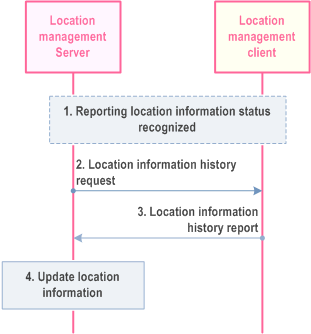
Step 1.
The location management client returns to report location information while there is a communication link between the location management client and location management server.
Step 2.
Location management server requests the stored location information.
Step 3.
The location management client responds to the location management server with one or several stored location information history reports.
Step 4.
The location management server updates the available location information with one or several stored location information and the optional MC service UE label, if present, from the location management client.
10.9.3.9.2.2 On-demand report location history procedure p. 225
The location management server can request stored location information at any time from the location management client, following a return to report location information to the location management server. The MC service server or the location management client may initiate the request of stored location information.
Figure 10.9.3.9.2.2-1 illustrates the procedure for the on-demand based usage of location history reporting.
Pre-conditions:
- The location management client 1 is configured to store location information, while not reporting location information to the location management server.
- The location management client 1 has stored location information based on triggering criteria in not reporting location information cases.
- The location management server may have none, a subset or all available stored location information reports from location management client 1.
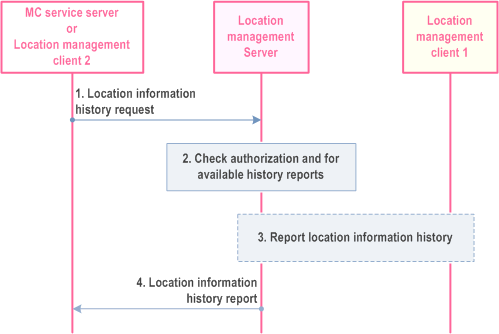
Step 1.
The MC service server or the location management client 2 initiate the location information history request to the location management server.
Step 2.
The location management server checks the authorization of this request and compares the location information history request with the already retrieved stored location information from location management client 1.
Step 3.
The location management server requests stored location information from location management client 1 according to the procedure described in clause 10.9.3.9.2.1 of the present document, if the desired stored location information is not available on the location management server.
Step 4.
The location management server reports the requested stored location information to the MC service server or location management client 2. The location management server reports the optional MC service UE label, if present, to the location management client 2.
10.9.3.9.3 Usage of status location history reporting procedure p. 226
10.9.3.9.3.1 Status location history reporting procedure (LMC - LMS) p. 226
The location management client can report the status of stored location information at any time to the location management server, following a return to report location information to the location management server.
Figure 10.9.3.9.3.1-1 illustrates the procedure for the usage of the status reporting from the location management client.
Pre-conditions:
- The location management client has returned to report location information and has stored location information reports.
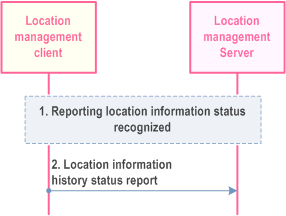
Step 1.
The location management client returns to report location information while there is a communication link between the location management client and location management server.
Step 2.
The location management client reports without a status request the status of the stored location information to the location information server.
10.9.3.9.3.2 On-demand status location history reporting procedure (LMS - LMC) p. 227
The location management server can request the status of stored location information at any time from the location management client, following a return to report location information to the location management server.
Figure 10.9.3.9.3.2-1 illustrates the procedure for the on-demand based usage of requesting the status of the stored location information from the location management client.
Pre-conditions:
- The location management client has returned to report location information and has stored location information reports.
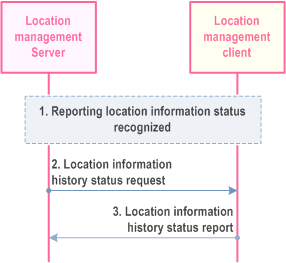
Step 1.
The location management client returns to report location information while there is a communication link between the location management client and location management server.
Step 2.
The location management server requests the status of the stored location information from the location management client.
Step 3.
The location management client reports the status of the stored location information to the location information server.
10.9.3.9.3.3 On-demand status location history reporting procedure p. 227
The MC service server or the location management client can request the status of stored location information at any time, following a return to report location information to the location management server.
Figure 10.9.3.9.3.3-1 illustrates the procedure for the on-demand based usage of the status location history reporting procedure.
Pre-conditions:
- The location management client 1 has returned to report location information and has stored location information reports.
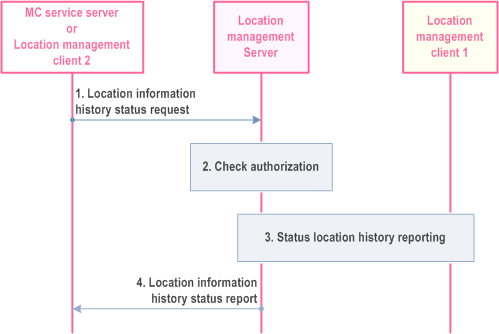
Step 1.
The MC service server or location management client 2 requests the status of the stored location information reports from the location management client 1.
Step 2.
The location management server checks the authorization of this request.
Step 3.
The location management server requests and receives the status report of the stored location information from location management client 1 according to the procedure described in clause 10.9.3.9.3.2 of the present document.
Step 4.
The location management server forwards this information to the MC service server or location management client 2.
10.9.3.9.4 Usage of cancel location history reporting procedure p. 228
10.9.3.9.4.1 General p. 228
The location management server can request cancellation of the transmission of location information history reports at any time following the start of transmission by sending a location information history cancel request to the reporting location management client. The MC service server or location management client could initiate the cancellation request, if those entities are aware of ongoing location information history reporting. The transmission cancellation does not have any effect on the configured triggering criteria in emergency cases, triggering criteria in non-emergency cases nor on the triggering criteria in not reporting location information cases.
10.9.3.9.4.2 Cancel location history reporting procedure (LMS - LMC) p. 228
Figure 10.9.3.9.4.2-1 illustrates the procedure for the cancellation on location history reporting from the location management server to the location management client.
Pre-conditions:
- The location management client has returned to report location information and has stored location information reports.
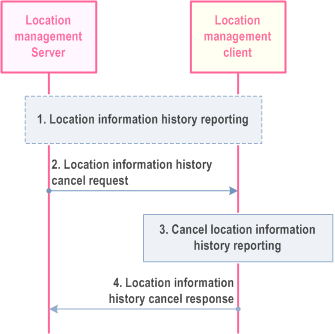
Step 1.
The location management client transmits stored location information while there is a communication link between the location management client and location management server.
Step 2.
The location management server requests the cancellation of the location information history reporting at any time during the transmission.
Step 3.
Location management client cancels the location information history reporting.
Step 4.
Location management client confirms the executed cancellation request.
10.9.3.9.4.3 Cancel location history reporting procedure p. 229
Figure 10.9.3.9.4.3-1 illustrates the procedure for the cancellation on location history reporting from the MC service server or location management client to the location management server.
Pre-conditions:
- The location management client 1 has returned to report location information and has stored location information reports.
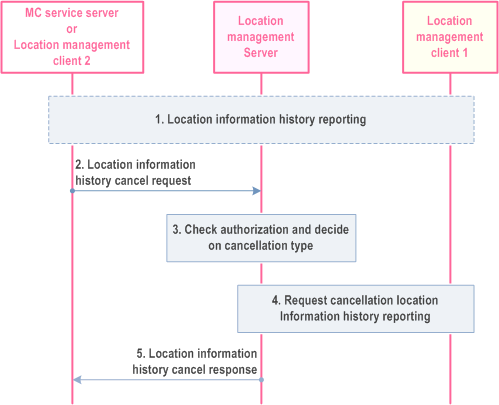
Step 1.
The location management client 1 transmits stored location information while there is a communication link between the location management client and location management server.
Step 2.
The MC service server or location management client 2 requests the cancellation of the location information history reporting at any time during the transmission.
Step 3.
The location management server checks the authorization of this request and decides whether to cancel the transmission from the reporting location management client 1 as described in clause 10.9.3.9.4.2, to cancel the transmission from the location management server or to cancel the transmission from both.
Step 4.
If there are no other authorized location management clients requesting the location history of location management client 1, the location management server executes the requested cancellation.
Step 5.
Location management server confirms the executed cancellation.
10.9.3.10 Usage of location information across MC systems procedure |R18| p. 230
10.9.3.10.1 General p. 230
Interconnected MC systems in either the same security domain or different security domains share location information either through the direct connection of the location management servers or through the connected MC gateway servers.
10.9.3.10.2 On-demand request of location information procedure p. 230
The MC service server or location management client in the primary MC system can request MC service user's location information, which is in the partner MC system, at any time by sending a location information request to the location management server at primary MC system.
Figure 10.9.3.10.2-1 illustrates the high level procedure of on-demand request of location information.
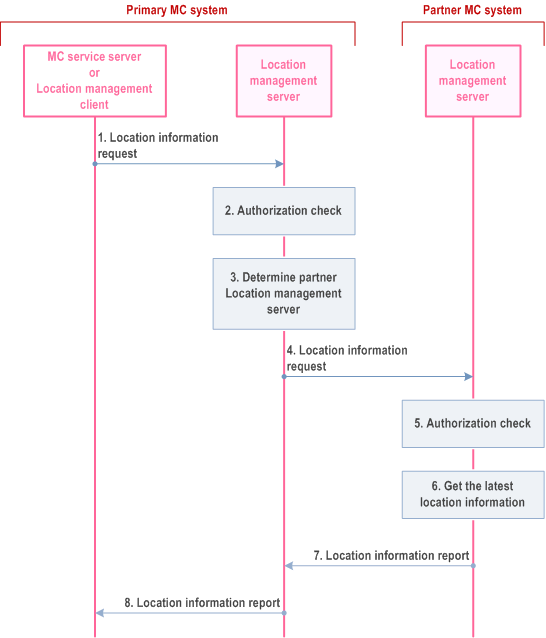
Step 1.
The MC service server or a location management client in the primary MC system requests on-demand location information of MC service user located in the partner MC system.
Step 2.
The location management server in the primary MC system checks if the provided information along with the configuration permit the request to proceed. It checks whether requesting location management client in the primary MC system is authorized to request the location information of the requested location management client in the partner MC system which is included in the location information request.
Step 3.
The location management server in the primary MC system determines that the request has a target in a different MC system.
Step 4.
The location management server in the primary MC system sends the on-demand location information request to the location management server in the partner MC system.
Step 5.
The location management server in the partner MC system checks if the provided information along with the configuration permit the request to proceed. It checks whether the requested location management client in the partner MC system is authorised to share its location information with the requesting location management client in the primary MC system.
Step 6.
The location management server at partner MC system updates the location information, according to the procedure described in clause 10.9.3.2 or provides stored location information, based on the configuration for on-demand requests.
Step 7.
The location management server in the partner MC system sends the location information report, described in clause 10.9.2.2, to the MC service server in the primary MC system.
Step 8.
If the requesting location information management client is still authorized to receive the location report, the location management server in the primary MC system sends the location information report to the requesting location information management client.
10.9.3.10.3 Event-triggered location information notification procedure p. 231
The location management client in the partner MC system provides, based on configuration, periodic location information, which will be also forwarded to the subscribed entities.
Figure 10.9.3.10.3-1 illustrates the high level procedure of event-triggered sharing of location information.
Pre-conditions:
- The location management client in the primary MC system has subscribed to receive location reports from the location client in the partner MC system according to the procedure described in clause 10.9.3.10.4.

Step 1.
The location management client in the partner MC system is triggered, based on configuration, to send a location information report, according to described triggers in clause 10.9.3.1.
Step 2.
The location management server in the partner MC system checks if the provided information along with the configuration permit the report to proceed.
Step 3.
The location management server in the partner MC system determines that the report has a target in a different MC system.
Step 4.
The location management server in the partner MC system sends the location information notification to the location management server in the primary MC system, according to the described information flow in Table 10.9.2.7-3.
Step 5.
The location management server in the primary MC system checks if the location management client is authorized to receive the location information and forwards the received location information, according to the procedure described in clause 10.9.3.6.1.
10.9.3.10.4 Location information subscription procedure p. 232
The location management client in the partner MC system provides, based on configuration, event triggered location information, which will be also forwarded to the subscribed entities.
Figure 10.9.3.10.4-1 illustrates the high level procedure of subscription to location information between interconnected MC systems.
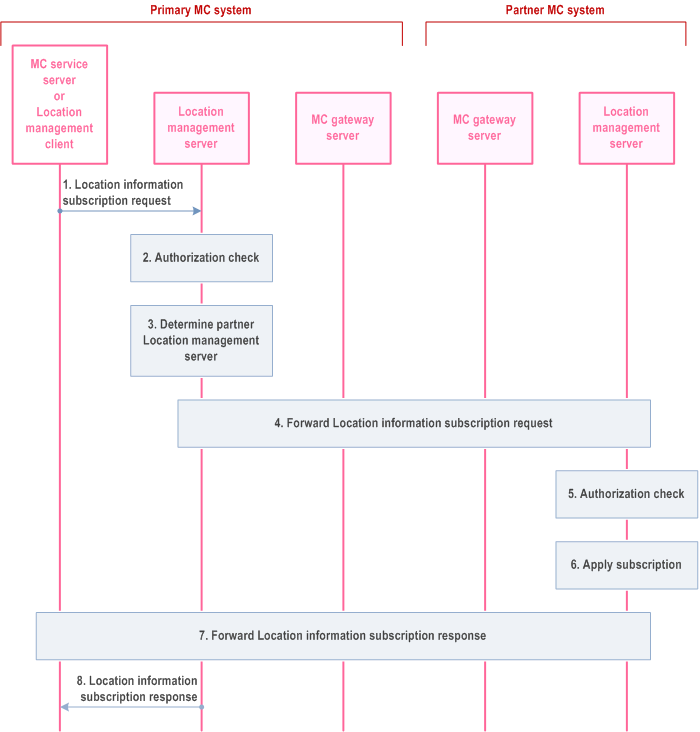
Step 1.
The MC service server or the location management client in the primary MC system request subscription to event-triggered location information of MC service users in the partner MC system by sending a location information subscription request to the location management server in the primary MC system, according to the described information flows in clause 10.9.2.5.
Step 2.
The location management server in the primary MC system checks if the provided information along with the configuration permit the request to proceed.
Step 3.
The location management server in the primary MC system determines that the request has a target in a different MC system.
Step 4.
The location management server in the primary MC system sends the location information subscription request to the location management server in the partner MC system, according to the described information flow in clause 10.9.2.5.
Step 5.
The location management server in the partner MC system checks if the provided information along with the configuration permit the request to proceed.
Step 6.
The location management server in the partner MC system applies the subscription.
Step 7.
The location management server in the partner MC system sends the location information subscription response to the location management server in the primary MC system.
Step 8.
The location management server in the primary MC system sends the location information subscription response to the requesting entity in the primary MC system, according to the described information flow in clause 10.9.2.6.
10.9.3.10.5 Location information cancel subscription procedure p. 234
The location management client in the primary MC system receives location information updates according to the subscriptions requested in the partner MC system. Those subscriptions can be cancelled anytime from the primary MC system.
Figure 10.9.3.10.5-1 illustrates the high level procedure of the subscription cancellation to location information between interconnected MC systems.
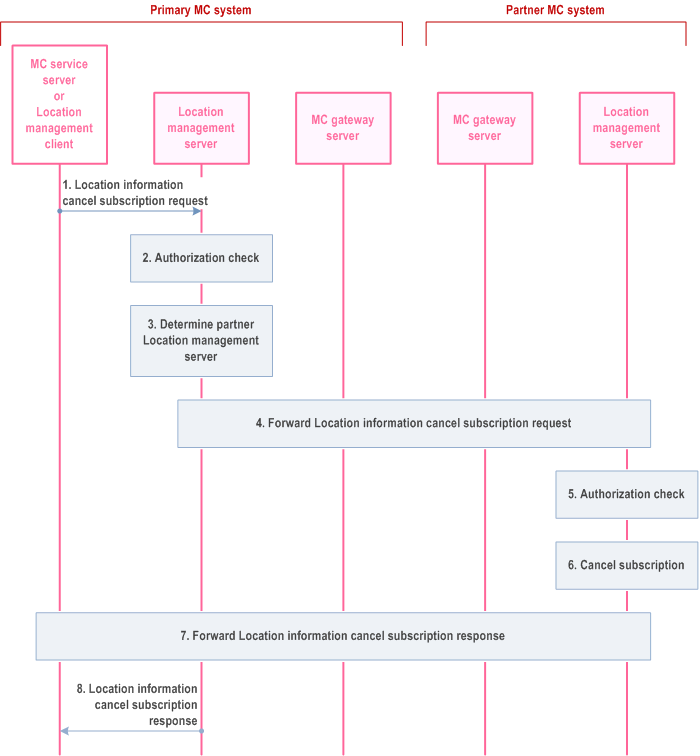
Step 1.
The MC service server or the location management client in the primary MC system request the cancellation of subscriptions to event-triggered location information of MC service users in the partner MC system by sending location information cancel subscription requests to the location management server in the primary MC system, according to the described information flows in clause 10.9.2.8.
Step 2.
The location management server in the primary MC system checks if the provided information along with the configuration permit the request to proceed.
Step 3.
The location management server in the primary MC system determines that the request has a target in a different MC system.
Step 4.
The location management server in the primary MC system sends the location information cancel subscription request to the location management server in the partner MC system, according to the described information flow in clause 10.9.2.8.
Step 5.
The location management server in the partner MC system checks if the provided information along with the configuration permit the request to proceed.
Step 6.
The location management server in the partner MC system cancels the subscription.
Step 7.
The location management server in the partner MC system sends the location information cancel subscription response to the location management server in the primary MC system.
Step 8.
The location management server in the primary MC system sends the location information cancel subscription response to the requesting entity in the primary MC system, according to the described information flow in clause 10.9.2.9.
10.9.3.10.6 Location reporting temporary configuration procedure p. 235
An authorized MC service user in the primary MC system in charge of MC service users either currently completely or partially operating in a partner MC system is able to configure event-based location information for the involved MC service users at any time by sending configuration parameters. Those configuration parameters are temporarily used, while the configuration parameters of the primary MC system are reinstated either by the configuration expiration criteria or by request from the authorized MC service user.
Figure 10.9.3.10.6-1 illustrates the high level procedure of location reporting temporary configuration procedure.
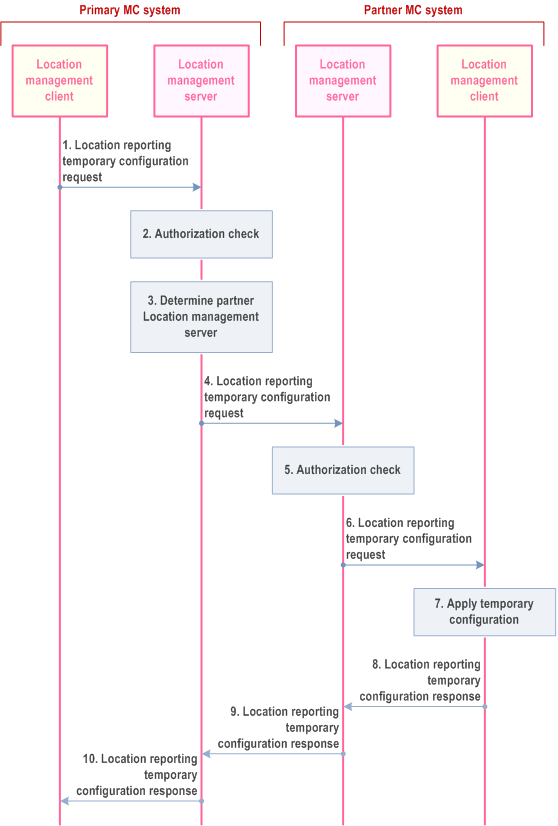
Step 1.
The location management client in the primary MC system requests to configure the location reporting of MC service user(s) located in the partner MC system.
Step 2.
The location management server in the primary MC system checks if the provided information along with the configuration permit the request to proceed.
Step 3.
The location management server in the primary MC system determines that the request has a target in a different MC system.
Step 4.
The location management server in the primary MC system sends the location reporting temporary configuration request to the location management server in the partner MC system.
Step 5.
The location management server in the partner MC system checks if the provided information along with the configuration permit the request to proceed.
Step 6.
The location management server in the partner MC system forwards the location reporting temporary configuration request to the location management client in the partner MC system. The location management server in the partner MC system may adjusts the configuration parameters.
Step 7.
The location management client in the partner MC system applies the temporary configuration parameters and stores the original configuration parameters as well as sets the configuration expiration criteria.
Step 8.
The location management client in the partner MC system sends the location reporting temporary configuration response to the location management server in the partner MC system. The location reporting temporary configuration response includes the full status report on all configuration parameters, even if only one configuration parameter has received a request of adaptation.
Step 9.
The location management server in the partner MC system sends the location reporting temporary configuration response to the location management server in the primary MC system.
Step 10.
The location management server in the primary MC system sends the location reporting temporary configuration response to the location management client in the primary MC system.
10.9.3.11 Restrict location information dissemination procedure |R18| p. 237
The location management client can control the location information dissemination at any time by sending a restrict location information dissemination request to the location management server, which will indicate to the location management server whether the location information can be disseminated further or not.
Figure 10.9.3.11-1 illustrates the high level procedure whether to enable/disable the restriction to distribute the location information further or not.
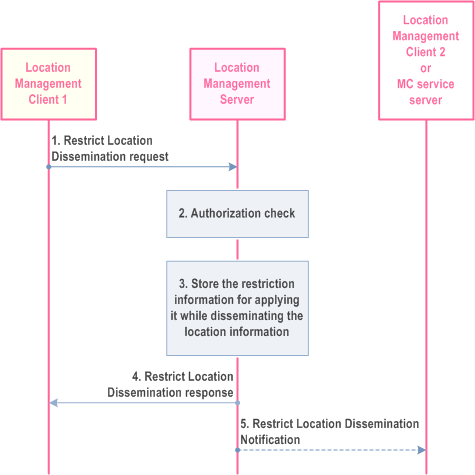
Step 1.
The location management client 1 initiates a request for restricting the location information dissemination, containing an indication to enable the restriction or disable the restriction. By default, the location management server can disable the restriction, i.e. location information of user can be distributed further. The request may provide the list of MC service IDs of MC service users (e.g. based on the role or selected users or any). The list could be pre-defined or dynamic or based on any other criteria.
Step 2.
The location management server checks if the location management client 1 is authorized to restrict the location information dissemination.
Step 3.
The location management server updates restriction information of the reporting location management client 1. If the location management server does not have the restriction record for the location information dissemination of the requesting location management client 1 before, then just store the restriction record for that location management client 1.
Step 4.
The location management server sends the restrict location information dissemination response to the location management client 1 to confirm the status of the restrict location information dissemination request.
Step 5.
The location management server may inform all the subscribed users (in accordance with local policies and local requirements) that the location information from this particular user will be provided or not by sending the restrict location information dissemination notification upon successfully applying restrictions on location dissemination as described in step 3 above.
10.9.3.12 Location reporting trigger override |R19| p. 238
10.9.3.12.1 General p. 238
For operational/technical reasons (e.g., in order to reduce the signalling load in a cell) an authorized user can override the aggregated trigger configuration for one or more reporting location management clients.
The location reporting trigger override procedures only affect the triggers configured by requesting MC service users. The location management server shall ensure that triggers originating from the MC service servers are not affected, in order not to disturb system operation.
10.9.3.12.2 Location reporting trigger override procedure p. 238
Figure 10.9.3.12.2-1 illustrates the high level procedure of trigger override.
Pre-conditions:
- MC service client 3 has subscribed to MC service client 1 as described in clause 10.9.3.5 and has applied location reporting triggers in MC service client 1 as described in clause 10.9.3.3.
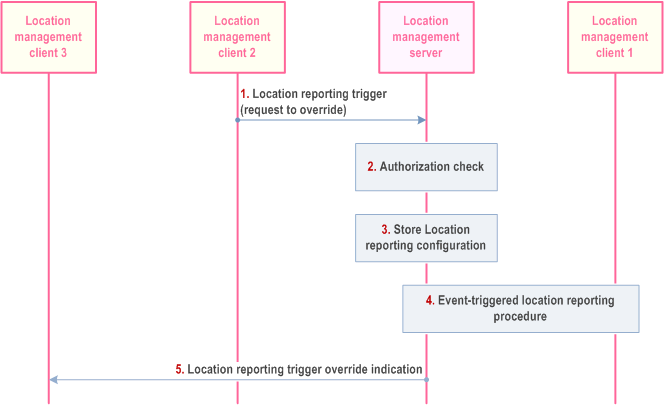
Step 1.
Location management client 2 (authorized MC service user) sends a location reporting trigger to the location management server requesting to override the existing triggers of location management client 1.
Step 2.
The location management server checks whether location management client 2 is authorized to override existing triggers of location management client 1.
Step 3.
The location management server stores locally the current location reporting configuration for location management client 1.
Step 4.
The location management server initiates an event-triggered location reporting procedure for location management client 1, applying the triggers requested by location management client 2 without performing aggregation of other trigger requests received from other location management clients.
Step 5.
The location management server informs location management client 3 about the location reporting trigger override by sending a location reporting trigger override indication.
10.9.3.12.3 Cancel location reporting trigger override procedure p. 239
Figure 10.9.3.12.3-1 illustrates the high level procedure of cancel trigger override.
Pre-conditions:
- MC service client 3 has subscribed to MC service client 1 as described in clause 10.9.3.5 and has applied location reporting triggers in MC service client 1 as described in clause 10.9.3.3.
- Previously MC service client 2 has initiated a trigger override procedure for MC service client 1 as described in clause 10.9.3.12.
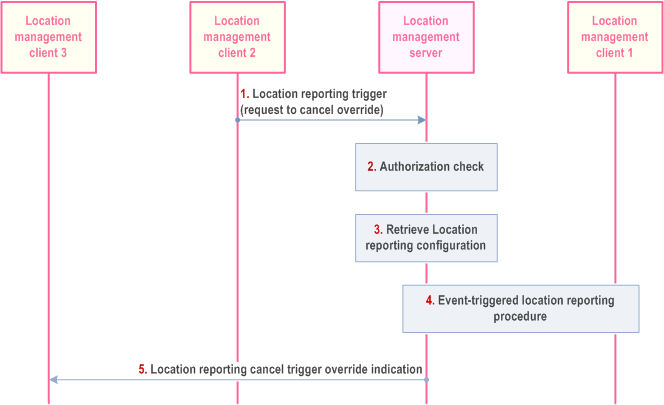
Step 1.
Location management client 2 (authorized MC service user) sends a location reporting trigger to the location management server requesting to cancel the trigger override for location management client 1.
Step 2.
The location management server checks whether location management client 2 is authorized to override the existing triggers of location management client 1.
Step 3.
The location management server retrieves the location reporting configuration for location management client 1 which was stored locally.
Step 4.
The location management server initiates an event-triggered location reporting procedure for location management client 1, restoring the triggers that were retrieved in step 3.
Step 5.
The location management server informs location management client 3 about the cancellation of the location reporting trigger override by sending a location reporting cancel trigger override indication.